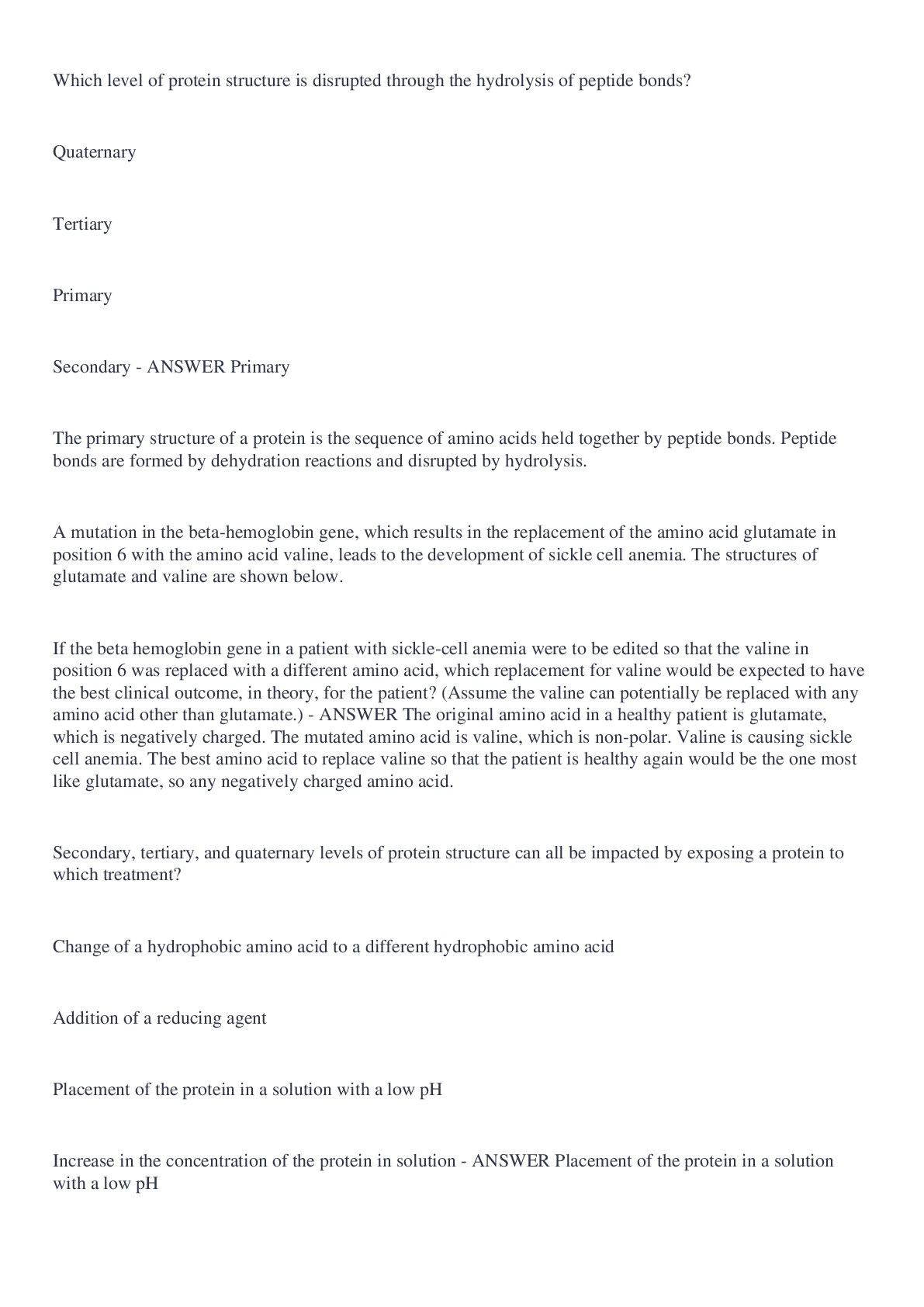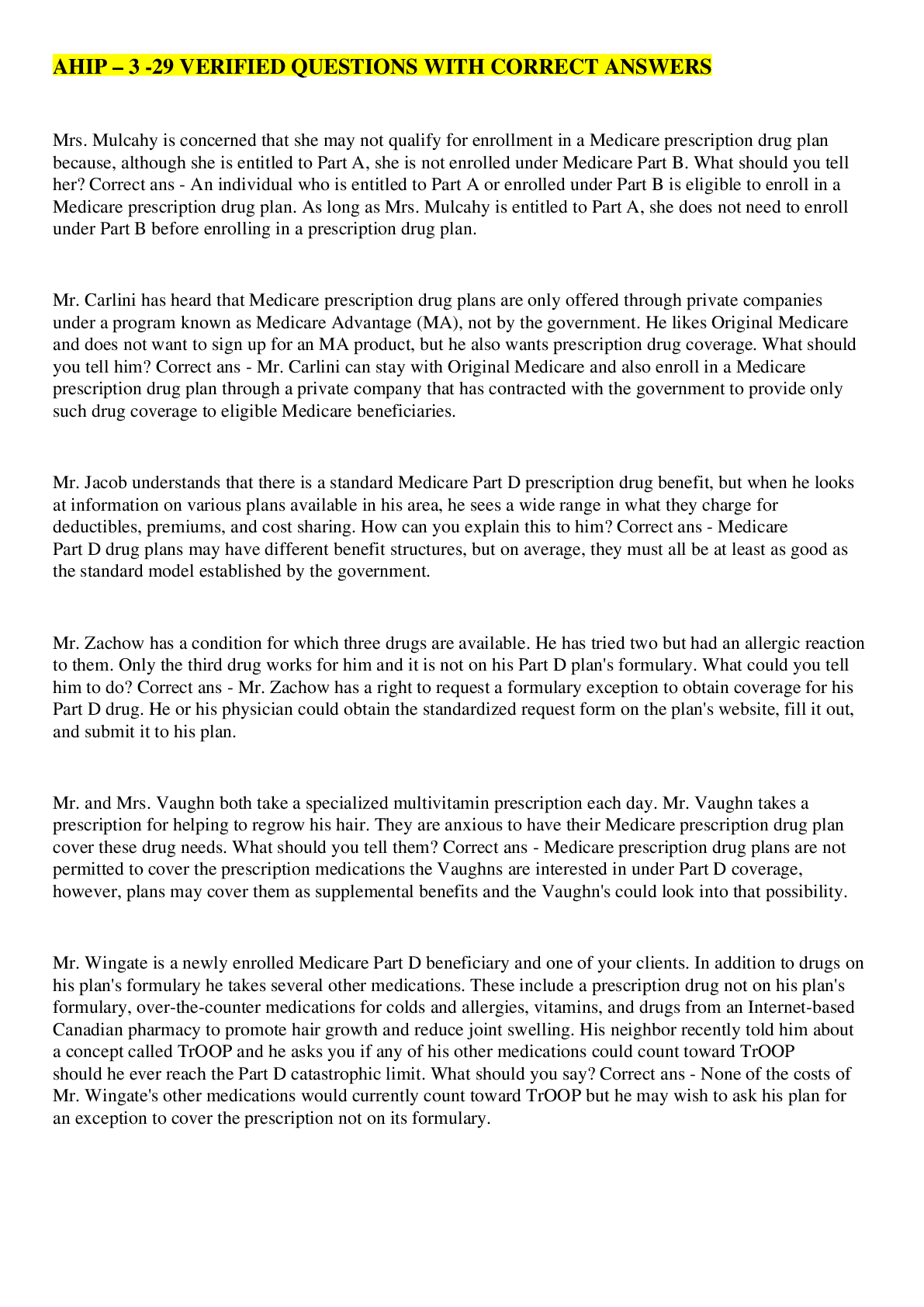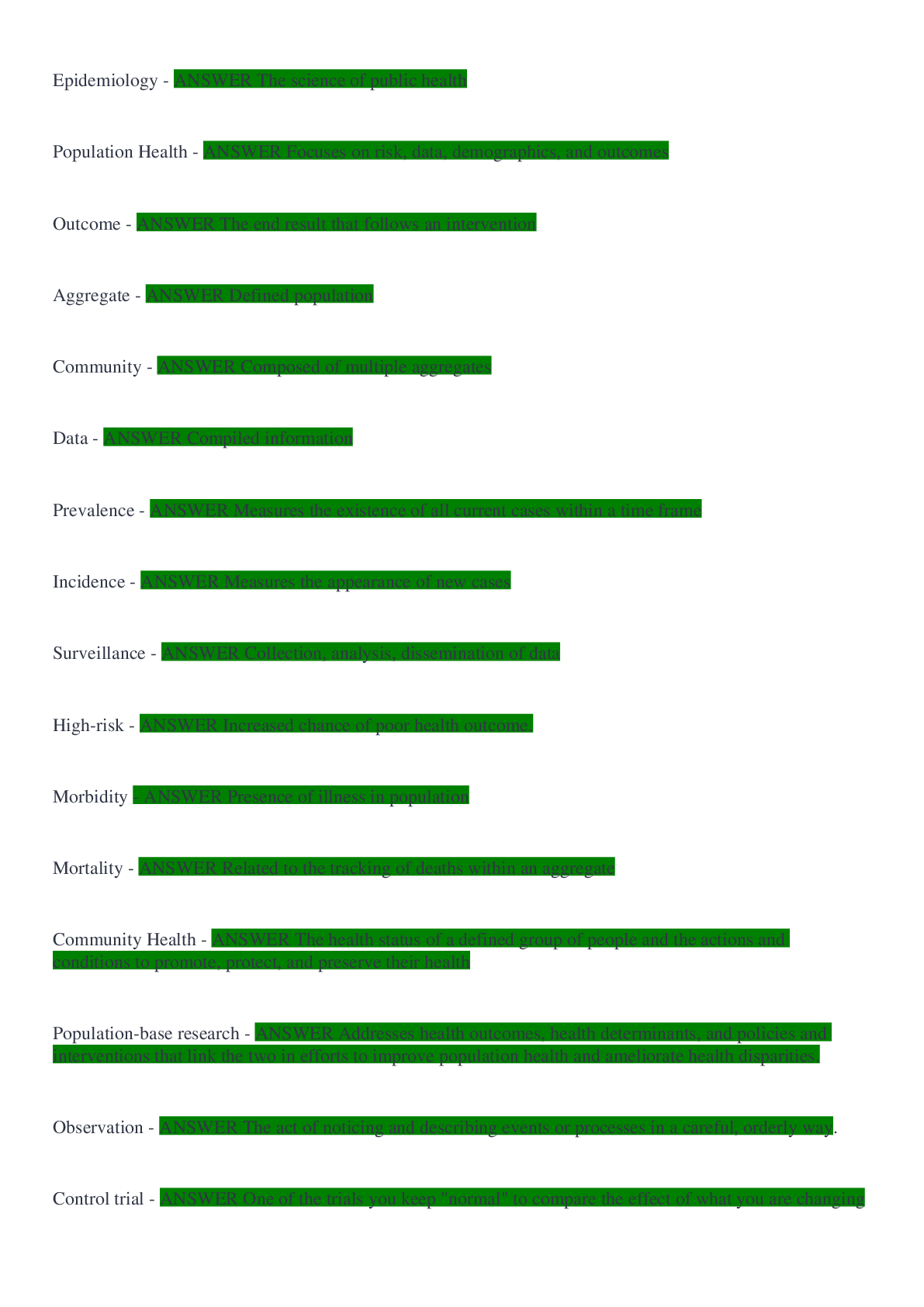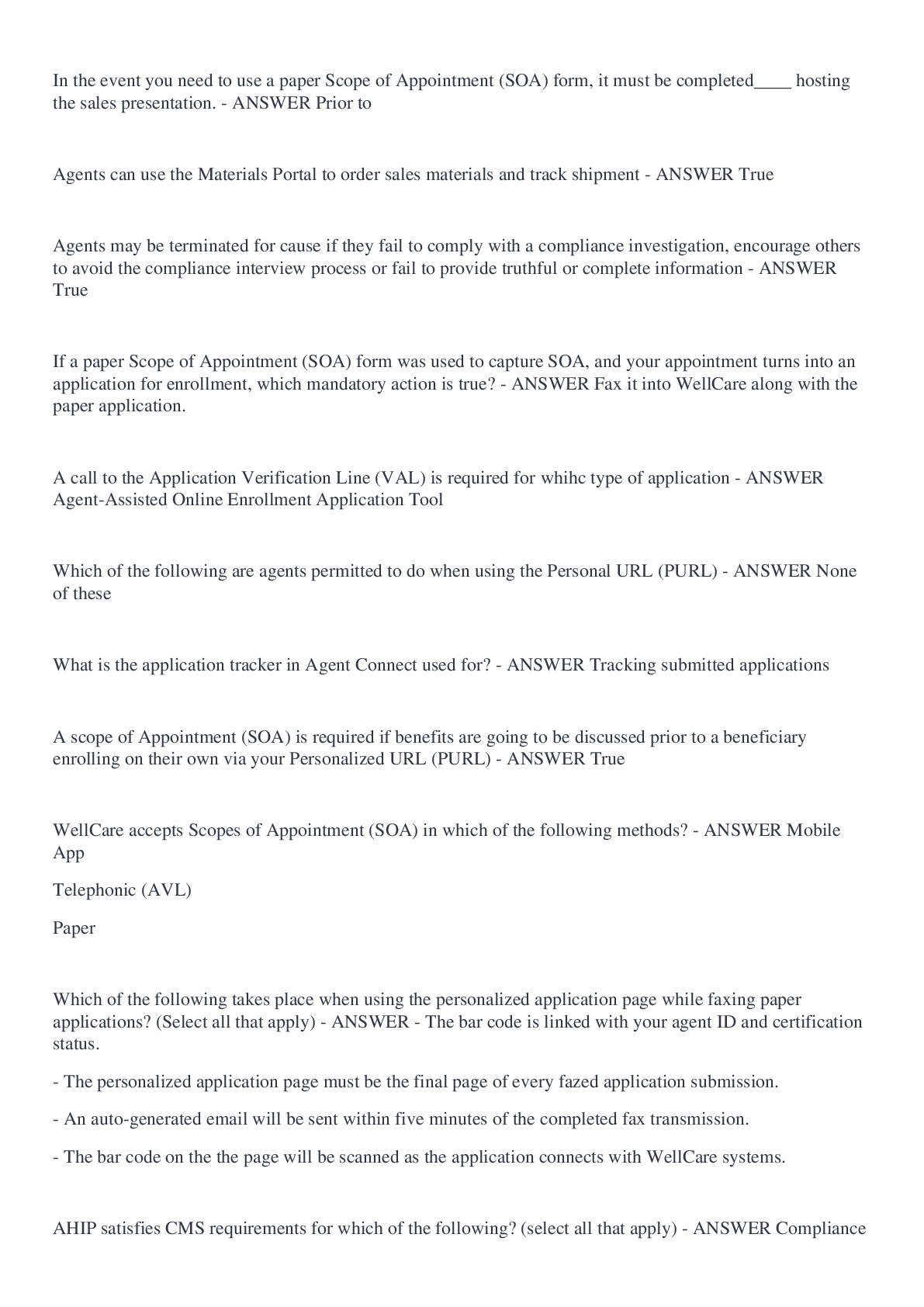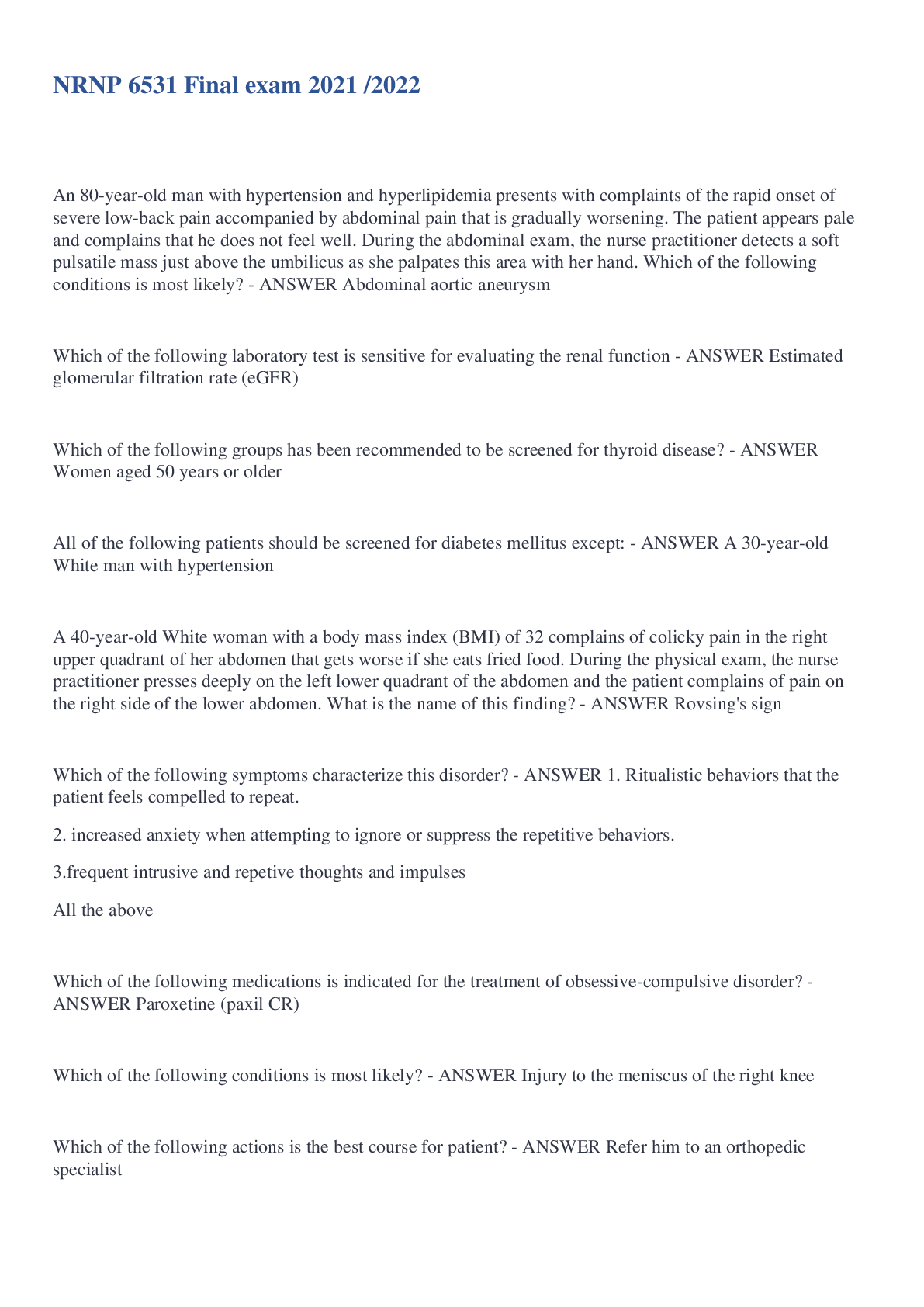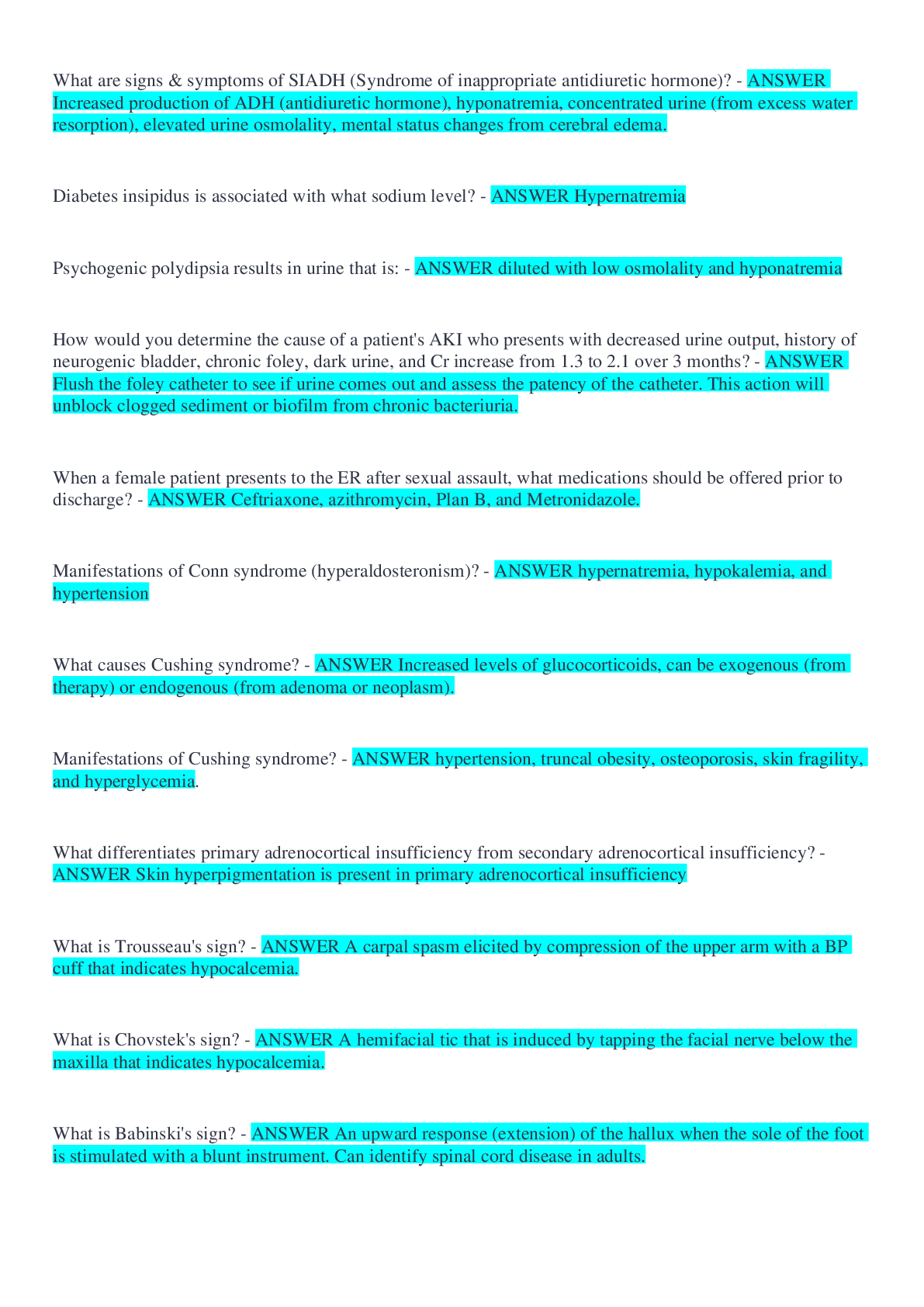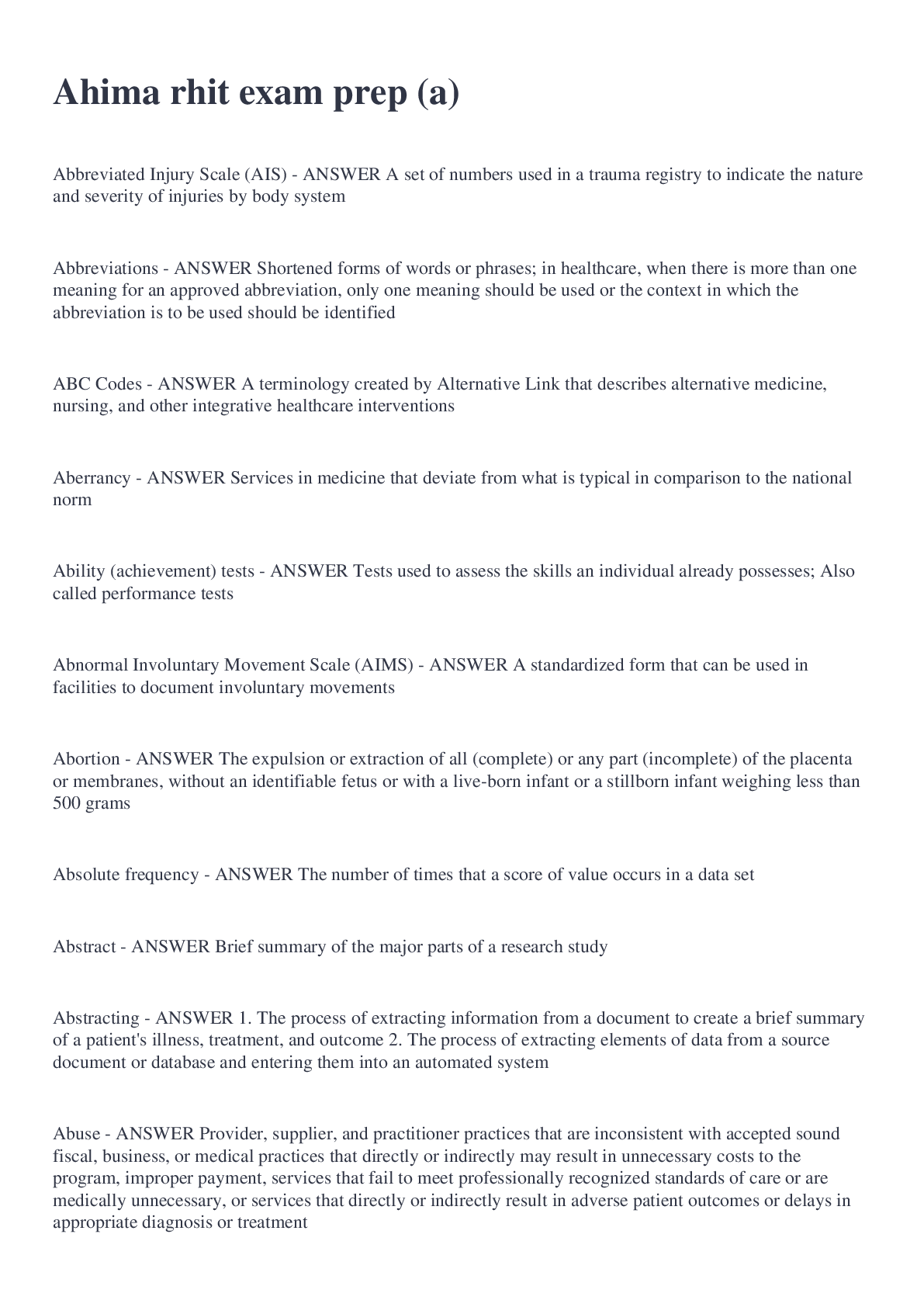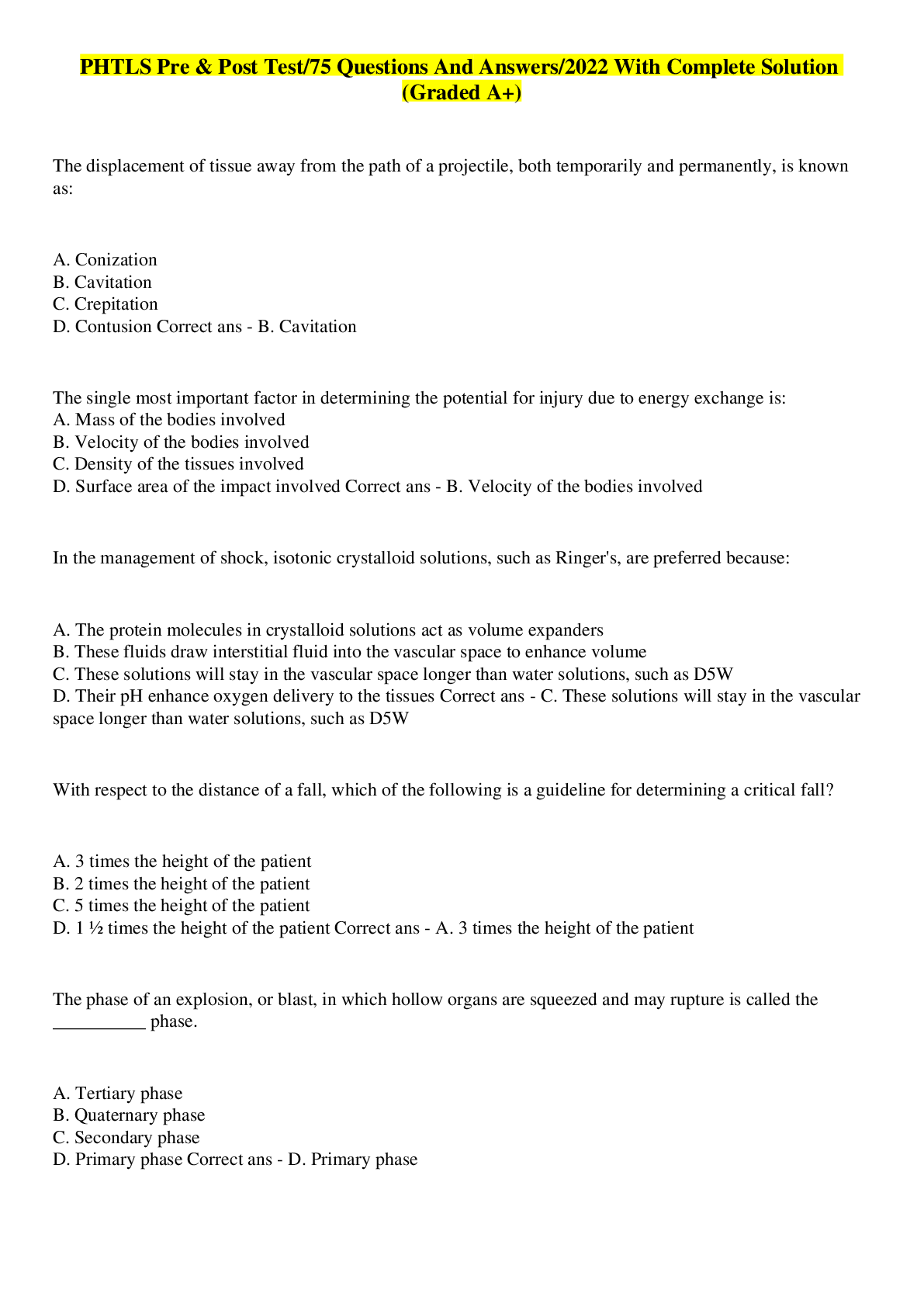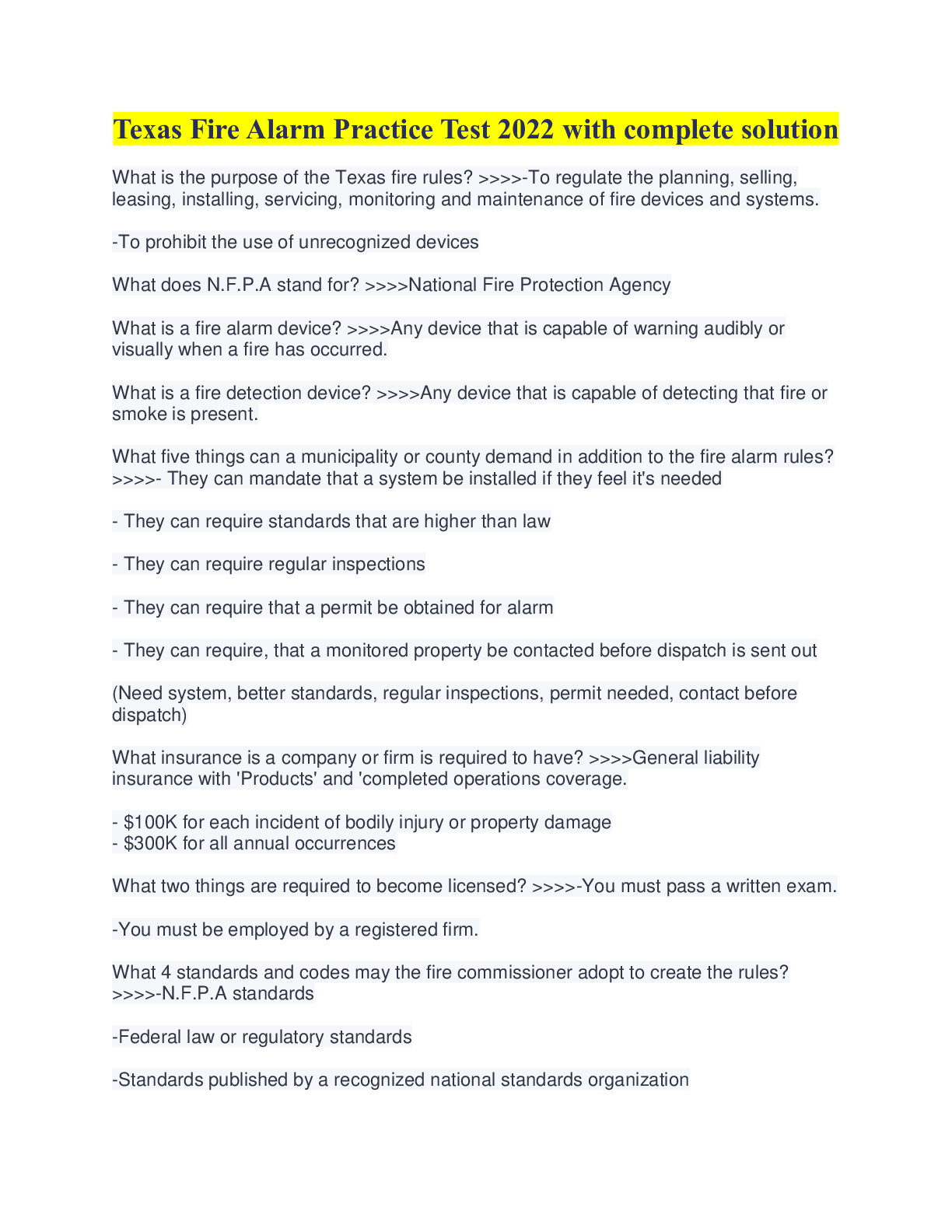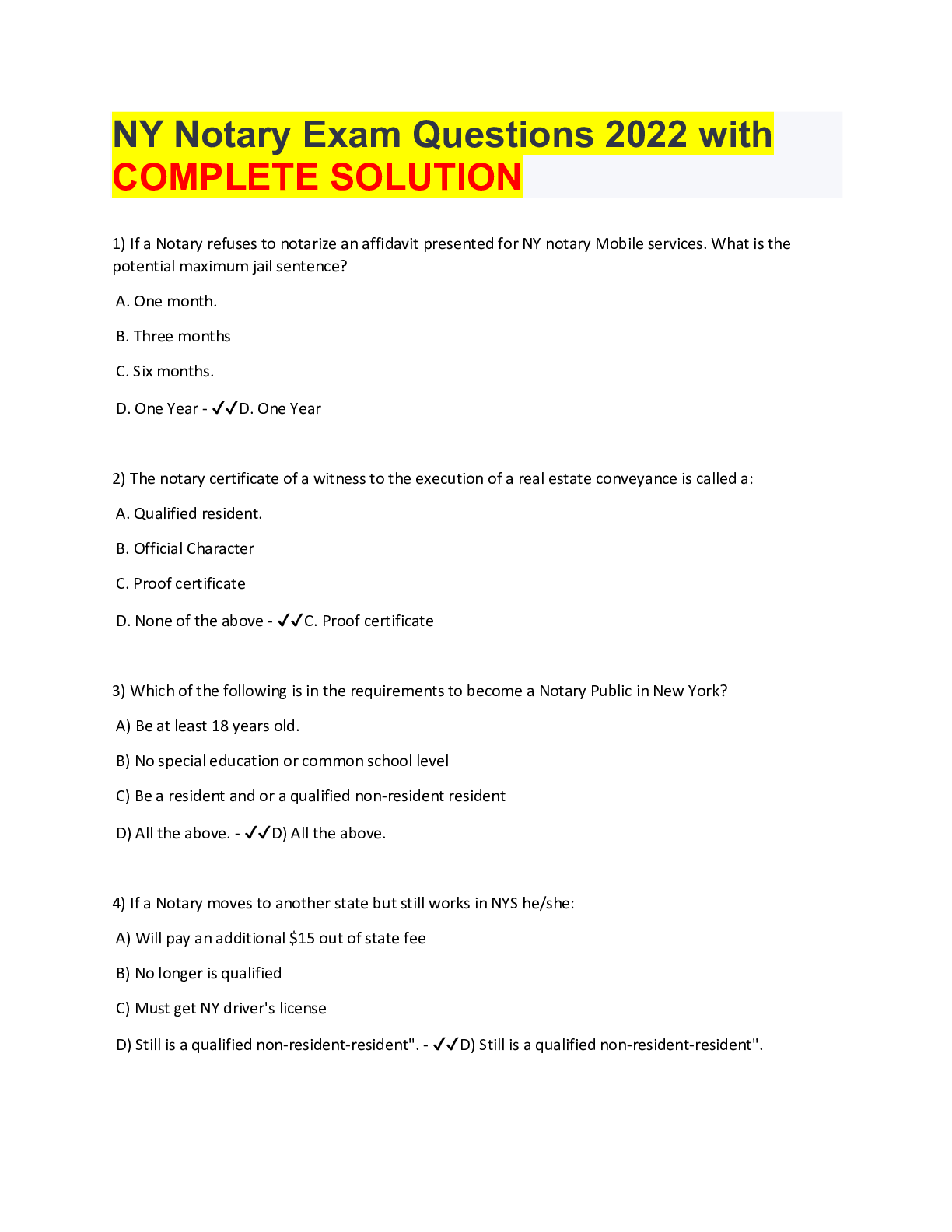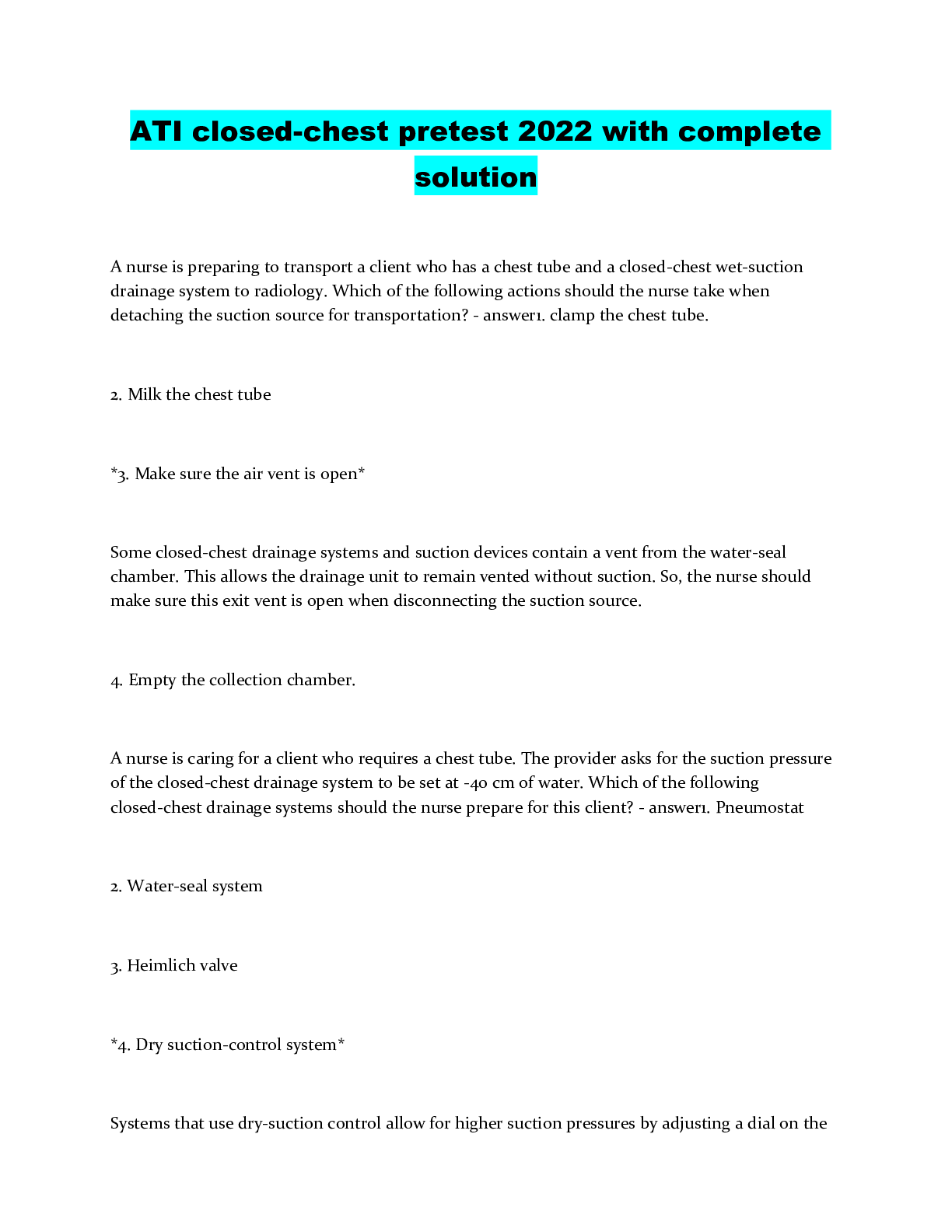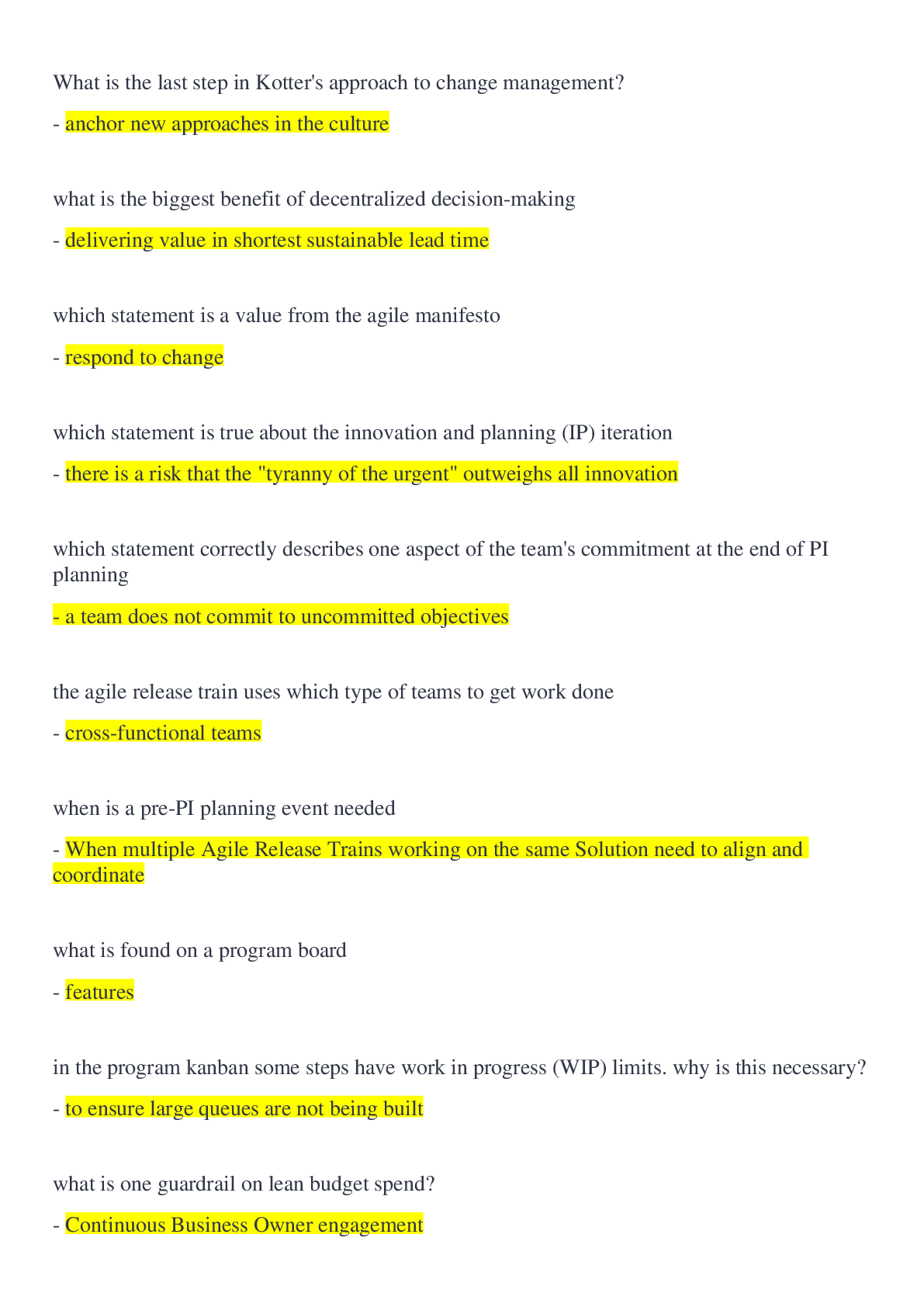Health Care > QUESTIONS & ANSWERS > tmc exam 2022 with complete solutions (All)
tmc exam 2022 with complete solutions
Document Content and Description Below
Romazicon (flumazenil) - ANSWER -antidote for benzodiazepines such as -GABA receptor antagonist - It can treat drowsiness caused by sedatives following surgery or drug overdose. Which of the fo... llowing can be used to estimate the level of Hemoglobin? - ANSWER RBC -RBC X 3 = hemoglobin with the use of pressure control the most important alarm is - ANSWER low volume -because the ventilator does not care about volume, the practitioner must. The most important alarm on a volume-cycled ventilator would be - ANSWER high pressure alarm Which of the following would be most effective at resolving a humidity deficit for a patient who is intubated with an 8.0-mm endotracheal tube - ANSWER wick or concha Which of the following would be most helpful for a patient with fixed upper airway obstruction? A. beta II agonist medication B. heliox therapy C. aerosolized epinephrine D. corticosteroids - ANSWER B. heliox therapy Heliox therapy is most appropriate. Helium, when combined with oxygen, is less viscous than pure oxygen or room air, which is made up mostly of nitrogen. This allows patients to breathe in gases with less airway resistance. -fixed obstruction means it cannot be resolved simply with bronchodilators or other immediate methods. which one should be treated first, ventilation or oxygenation - ANSWER ventilation the patient is over oxygenating AND hyperventilating which one should you treat first? - ANSWER over oxygenation -To address over-oxygenation one can either change the PEEP or the FIO2. You will always want to lower the FIO2 below 60% before changing PEEP. ways to decrease CO2 - ANSWER increase the Vt increase the rate remove dead space What would occur on a time-cycled ventilator with a fixed rate if the inspiratory flow rate were increased? A. increase in tidal volume B. decrease in inspiratory time C. decrease in tidal volume D. increase in inspiratory time - ANSWER A. increased in tidal volume On a time-cycled ventilator inspiratory time is predetermined. So, if the flow rate is increased while the mandatory rate is unchanged, the result would be an increase in tidal volume. Which of the following is the most significant complication of bronchoscopy? A. laryngospasms B. hypotension C. vagal nerve stimulation D. coughing - ANSWER A. laryngospasm -This tendency may be reduced by administering aerosolized Lidocaine or any other tissue numbing agent prior to the procedure. What is the respiratory therapist observing if monitoring the total amount of gas exhaled in 60 seconds after excluding dead space? A. minute ventilation B. dead space ventilation C. alveolar minute ventilation D. maximum voluntary ventilation - ANSWER c. alveolar minute ventilation Examining the breathing rate over a period of 60 seconds and multiplying it times the tidal volume gives you minute ventilation. If deadspace is subtracted from that volume then what is being observed is alveolar minute ventilation. education and direction for the performance of positive expiratory pressure (PEP) therapy - ANSWER Proper instructions for the use of a PEP therapy device includes "inhaling deeply and exhaling actively". equations to determine cardiac output - ANSWER fick equation co= SVxHR Which of the following would result in an increase in pulmonary capillary wedge pressure? A. decrease in pulmonary vascular resistance (PVR) B. cor pulmonale C. dehydration D. mitral valve stenosis - ANSWER D. mitral valve stenosis If mitral valve stenosis is present, blood would have difficulty transitioning the left ventricle. This would result in a backup pressure occurring and an elevation of the PCWP. A patient is on 70%/30% heliox therapy by nonrebreathing mask. If flowing through an oxygen flow meter, what is the actual flow of the mixture if the flow meter indicates 10 L/min? A. 5 L/min B. 8 L/min C. 18 L/min D. 16 L/min - ANSWER D. 16 When helium-oxygen mixtures are run through flow meters that are intended for oxygen only, the indicated flow on the flow meter is inaccurate. This is because the helium-oxygen mixture is less viscous and does not push the indicator ball up as much as does oxygen. In this case, a correction factor must be used depending upon the mixture percentage. For an 80/20% mixture a correction factor of 1.8 must be used. A 70/30% mixture has a correction factor of 1.6 and a 60/40% mixture has a correction factor of 1.4. In this problem the 70/30% mixture factor of 1.6 must be multiplied by the indicated flow on the oxygen flow meter to calculate actual total gas flow. When we do this we get a total gas flow of 16 L/min. Popping sensations, also referred to as crackling sensations, during palpation of the tissues of the upper chest and neck are related to subcutaneous emphysema, which is a condition of air entering the dermal and subdermal spaces. It is usually caused by - ANSWER a mal-positioned tracheostomy tube. Pulse oximeters are also known as single wavelength spectrophotometers. There are multiple reasons why they may read inaccurately. Those reasons include: - ANSWER high ambient light, the use of fingernail polish, poor peripheral perfusion, and marked hypotension The incidence of ventilator-associated pneumonia, or VAP, is lowered by - ANSWER using a closed system suction catheter, periodically discontinuing sedation, keeping the patient and semi-Fowler's position, and proper handwashing among caregivers Which of the following airway clearance therapies should be administered first in the order of therapy? A. postural drainage and percussion B. nasal tracheal suctioning C. aerosolized Acetylcysteine (Mucomyst) D. verbal coaching for coughing - ANSWER C -aerosolized Acetylcysteine (Mucomyst) the first most logical step would be to thin secretions through use of the medication Mucomyst. The next step, would be postural drainage and percussion followed by verbal coaching for coughing and possibly nasal tracheal suctioning. Digitalis - ANSWER strengthens the contraction of the heart muscle, slows the heart rate, and helps eliminate fluid from body tissues Which of the following is most indicative of a pulmonary embolism? A. increased CVP, decreased PAP B. decreased CVP, decreased cardiac output C. increased PAP, decreased PCWP D. increased PCWP, decreased cardiac output - ANSWER C. increased PAP, decreased PCWP An increased PAP followed by a decreased PCWP indicates that blood is having difficulty flowing through the lung. When we need to raise CO2 there are three choices - - ANSWER decreasing tidal volume, decreasing rate, or adding dead space The use of PEP therapy is contraindicated by - ANSWER epistaxis and a middle ear infection. Paradoxical chest movement is an indication - ANSWER individual ribs are fractured in two or places, which causes the area of the rib cage to move in with inhalation while the rest of the chest moves out. Exosurf - ANSWER CLASS: ARTIFICIAL SURFACTANT IMMATURE NEONATAL LUNGS A left-to-right shunt, due to a leaking septum wall in the heart, is best determined by an increase in mixed venous oxygen saturation. From what location would the respiratory therapist recommend blood extraction for analysis to determine mixed venous oxygen saturation? A. pulmonary artery B. vena cava C. pulmonary vein D. aorta - ANSWER A. pulmonary artery Mixed venous blood, for the assessment of oxygen saturation, is taken from the distal port of the pulmonary artery catheter, or the pulmonary artery Flipped T waves on ECG waveform indicate - ANSWER cardiac ischemia. The best way to treat this is to administer oxygen to the patient One treatment for metabolic alkalosis is to administer - ANSWER potassium chloride The lowest inflection point on a pressure-volume ventilator graphic is an indication of - ANSWER the minimum pressure needed to keep alveoli open. Non-deadly arrhythmias, such as atrial tachycardia, may be addressed through - ANSWER cardioversion Which of the following descriptions most typifies the sound a therapist might here on a patient with a pleural friction rub? A. grating sound B. scattered crackles C. egophany D. sonorous - ANSWER A. grating sound When the patient is placed in an aircraft that does not maintain cabin pressure, any changes in arterial oxygenation result primarily from - ANSWER a change in alveolar oxygen tension or PAO2. Oxygen Index (OI) - ANSWER Paw x FiO2/PaO2 (100) is a value that takes into consideration FIO2, PaO2 levels, and inspiratory pressures. Endrophonium (Tensilon) - ANSWER It can help diagnose myasthenia gravis so that doctors select the proper treatment. It can also reverse the effect of certain muscle relaxants during surgery or after an overdose. the normal systemic vascular resistance SVRI is - ANSWER 1800-2400 mixed venous blood should be taken from - ANSWER the distal end of pulmonary artery catheter to determine PvO2 altitude causes hypoxemia due to barometric pressure which result in - ANSWER decreased alveolar oxygen tension or PAO2 straw colored stain on skin of a newborn indicates - ANSWER presence of meconium A patient that is taking nebulizer treatments needs to be able to demonstrate - ANSWER manual dexterity, and the ability to hold and manipulate the nebulizer Which of the following would be most beneficial in resolving microatelectasis? A. Chest tubes B. Thoracentesis C. Percutaneous ventilation D. Bronchoscopy - ANSWER D. Bronchoscopy A bronchoscopy would be most beneficial because it can ventilate and recruit alveoli in the lung. The other options will not decrease atelectasis A patient with increased airway resistance from a fixed upper airway obstruction would benefit most from which of the following? A. epinephrine B. heliox therapy C. aerosolized atropine D. bronchodilator therapy - ANSWER B. Heliox therapy An air-entrainment jet nebulizer is set at 50%. The respiratory therapist analyzes the oxygen coming from the end of the tubing and finds it is 60%. Which of the following most likely explains this finding? A. low flow through the jet orifice B. leak in the tubing C. excess water in the tubing D. poorly calibrated analyzer - ANSWER C. excess water in the tubing When administering oxygen by any device that has a venturi mechanism, back pressure on the venturi will slow the speed of gas, decrease room air entrainment, and result in an increase in FIO2. Of the options offered, only excess water in the tubing would cause this type of back pressure. During the preoperational test of the ventilator, the respiratory therapist notices the galvanic analyzer on the ventilator is reading erroneously low. Which of the following can the respiratory therapist do to correct the problem? A. tag the ventilator as non-functional and avoid placing it in service B. change the fuel cell C. replace the electrolyte solution in the analyzer D. replace the analyzer batteries - ANSWER B. change the fuel cell A galvanic oxygen analyzer will read erroneously under two conditions: the probe or the fuel cell is depleted or the analyzer requires calibration. In this case the probe, which provides the energy for the analyzer, is the most likely culprit and should be changed. While monitoring a patient receiving mechanical ventilation, the respiratory therapist notices the low-pressure and low exhaled volume alarms are sounding. Which of the following could be the cause? A. excess water in the inspiratory limb of the circuit B. kinked endotracheal tube C. disconnected thermistor line D. herniated endotracheal tube cuff - ANSWER C. disconnected thermistor line If you have a low pressure or low exhaled volume ventilator alarm, you must look for the problem that could cause that specific type of alarm. If you look at the answers, a kink in the endotracheal tube would cause a high-pressure alarm so that cannot be the cause. Excess water in the limbs of the circuit would do the same. A high-pressure alarm would also develope if there is a herniated endotracheal tube cuff. This leaves the only possible answer which is a disconnected thermistor line. The high pressure alarm is sounding on a patient receiving volume controlled ventilation. The respiratory therapist should FIRST A. provide manual ventilation B. cancel the alarm C. observe the alarm panel to determine source D. suction the patient - ANSWER The NBRC knows that in real life, when you hear a ventilator alarm, you're tempted to cancel the alarm or attempt to immediately solve the problem. However, the correct answer is always to first provide manual ventilation to the patient. This is true of any ventilator alarm. Your first action should be to stabilize the ventilatory status of the patient, and then troubleshoot the problem. Anectine (succinylcholine) - ANSWER neuromuscular blocker is the medication that manifests muscle twitching about the face and neck when it is working properly. SVC Maneuver - ANSWER A respirometer is the most important piece of equipment when measuring an SVC Inspiratory muscle strength is determined by - ANSWER measuring the maximum inspiratory pressure. This is done with a pressure manometer. PAP normal value - ANSWER the normal systolic PAP ranges from 15 to 25 mm Hg and the diastolic PAP from 6 to 12 mm Hg. When a patient on a ventilator is unable to exhale completely before the inhalation cycle starts, the result will be air-trapping, which will result in - ANSWER auto peep While assisting a physician during a bronchoscopy procedure, the therapist notices bright red blood in the specimen tube. The therapist should prepare which of the following NEXT? A. Heparin B. Atropine C. epinephrine D. cold normal saline - ANSWER C. epinephrine The installation of epinephrine down the bronchoscope to an actively bleeding site will help to immediately stop the bleeding. This should be the first step in treating a bleed in the bronchial tree. The next step should be to compress the site with the bronchoscope followed by the insertion of the Fogarty catheter to tamponade the bleeding site. The device that may be attached to the end of the ET tube that allows PEEP to be maintained during a bronchoscopy is called - ANSWER Bodai adapter A patient is undergoing a full cardiopulmonary arrest. The patient is intubated and is being monitored with an infrared capnographic device. PetCO2 data is showing 3%. Which of the following is most appropriate? A. increase alveolar ventilation B. clean the infrared device C. recalibrate the capnometer D. obtain PaCO2 by a Douglas bag - ANSWER A. increase alveolar ventilation An end-tidal CO2 of only 3% is low. This indicates poor ventilation. In looking at the answers the best one is poor alveolar perfusion. A clean infrared device does not relate and the calibration of the capnograph is not pertinent. end tidal CO2 normal range - ANSWER 5% to 6% CO2, which is equivalent to 35-45 mmHg. Which of the following can be examined to initially determine the approximate position of the oral endotracheal tube? A. diaphragmatic excursion B. chest radiograph C. ET tube markings at the lips D. lateral neck radiograph - ANSWER C. ET tube markings at the lips Cardiac output equation - ANSWER CO = HR x SV A volume type incentive spirometer measures - ANSWER IC inspiratory capacity C(a-v)O2 - ANSWER CaO2 - CvO2 For this question you must memorize the components that make up CaO2. They are: hemoglobin, PaO2, and SaO2. Additionally, once you know the CaO2, simply subtract the CvO2 to get C(a-v)O2. A therapist is unable to obtain a reading with a galvanic-type oxygen analyzer when attempting to measure oxygen percentage inside an isolette while the red warning flag is active. The therapist should? A. discontinue the red-flag warning system B. change the electrode C. replace the batteries D. replace the electrolyte solution - ANSWER B. change the electrode When a galvanic-type oxygen analyzer fails to produce a reading, it is likely a problem with the power source. These type of analyzers do not have batteries. The electrode is in essence a battery. So, the solution is to change the electrode. The electrode is also called the fuel cell. A patient is receiving non-invasive positive pressure ventilation by mask with an IPAP of 16 cmH2O and an EPAP of 8 cmH2O. Corresponding blood gas data is as follows: pH 7.29 PaCO2 51 mmHg PaO2 108 mmHg [Show More]
Last updated: 1 year ago
Preview 1 out of 27 pages
Reviews( 0 )
Document information
Connected school, study & course
About the document
Uploaded On
Jul 24, 2022
Number of pages
27
Written in
Additional information
This document has been written for:
Uploaded
Jul 24, 2022
Downloads
0
Views
37





